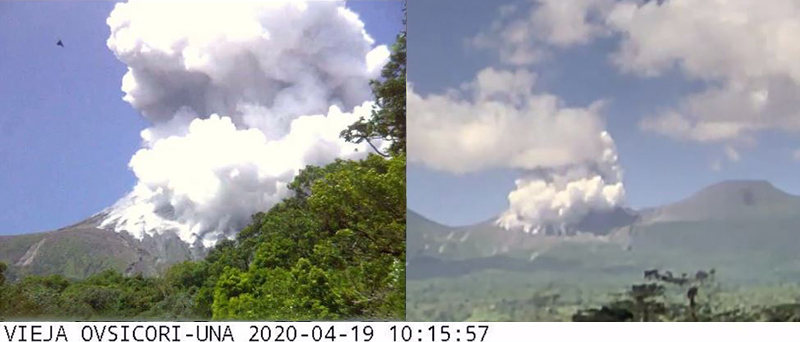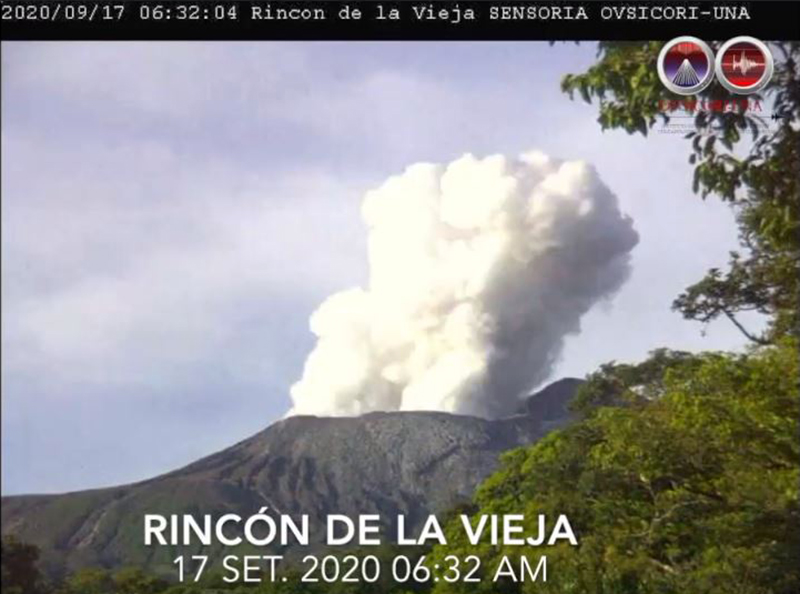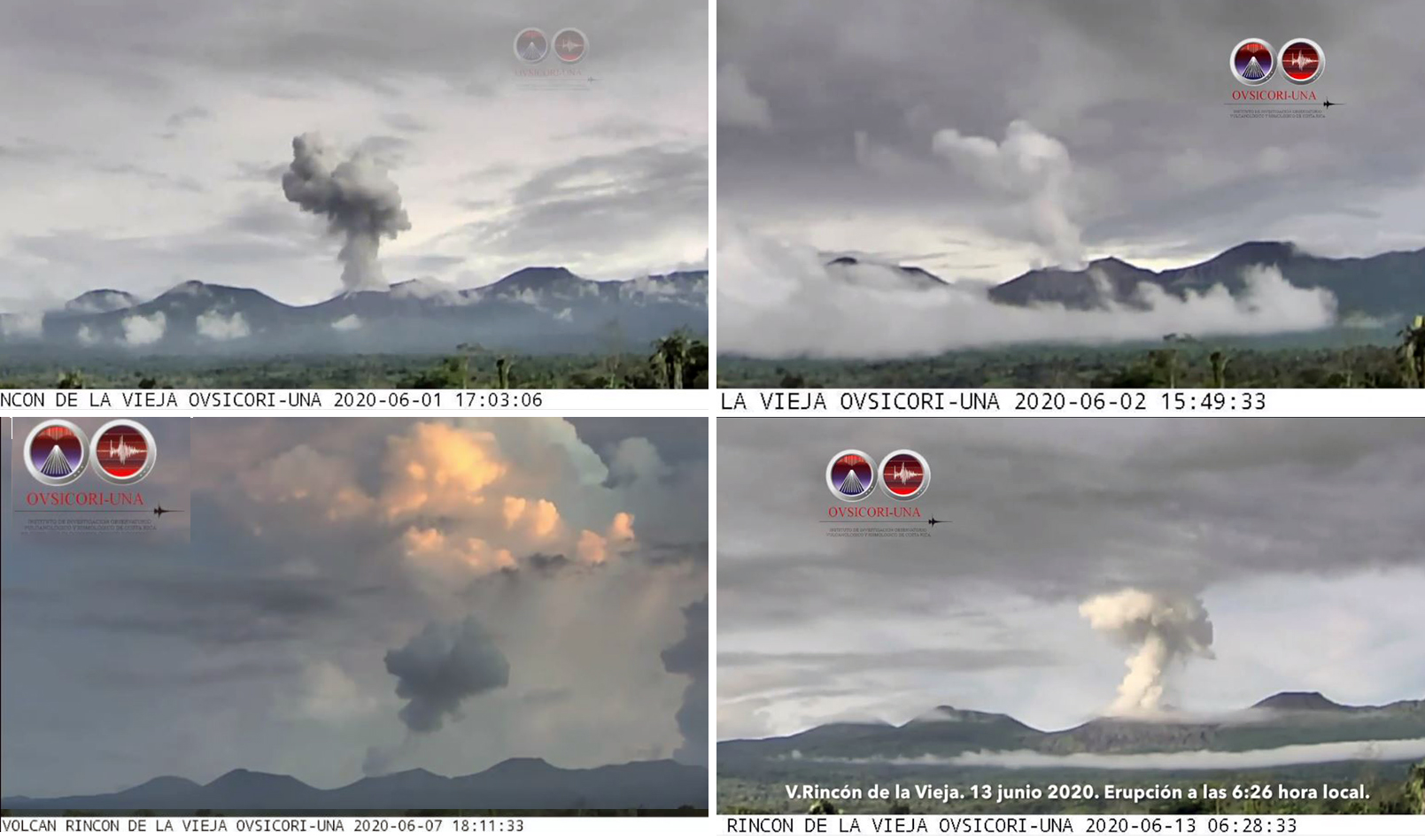Report on Rincon de la Vieja (Costa Rica) — October 2020
Bulletin of the Global Volcanism Network, vol. 45, no. 10 (October 2020)
Managing Editor: Edward Venzke.
Edited by Kadie L. Bennis.
Rincon de la Vieja (Costa Rica) Frequent small phreatic explosions with intermittent ash plumes during April-September 2020
Please cite this report as:
Global Volcanism Program, 2020. Report on Rincon de la Vieja (Costa Rica) (Bennis, K.L., and Venzke, E., eds.). Bulletin of the Global Volcanism Network, 45:10. Smithsonian Institution. https://doi.org/10.5479/si.GVP.BGVN202010-345020
Rincon de la Vieja
Costa Rica
10.83°N, 85.324°W; summit elev. 1916 m
All times are local (unless otherwise noted)
Rincón de la Vieja is a remote volcanic complex in Costa Rica that contains an acid lake. Frequent weak phreatic explosions have occurred since 2011 (BGVN 44:08). The most recent eruption period began in January 2020, which consisted of small phreatic explosions, gas-and-steam plumes, pyroclastic flows, and lahars (BGVN 45:04). This reporting period covers April through September 2020, with activity characterized by continued small phreatic explosions, three lahars, frequent gas-and-steam plumes, and ash plumes. The primary source of information for this report is the Observatorio Vulcanologico Sismologica de Costa Rica-Universidad Nacional (OVSICORI-UNA) using weekly bulletins and the Washington Volcanic Ash Advisory Center (VAAC).
Small, frequent, phreatic explosions were common at Rincón de la Vieja during this reporting period. One to several eruptions were reported on at least 16 days in April, 15 days in May, 8 days in June, 10 days in July, 18 days in August, and 13 days in September (table 5). Intermittent ash plumes accompanied these eruptions, rising 100-3,000 m above the crater and drifting W, NW, and SW during May and N during June. Occasional gas-and-steam plumes were also observed rising 50-2,000 m above the crater rim.
Table 5. Monthly summary of activity at Rincón de la Vieja during April through September 2020. Courtesy of OVSICORI-UNA.
| Month | Minimum total days of eruptions | Ash plume height (m above the crater) | Notable plume drift | Gas-and-steam plume height (m above the crater) |
| Apr 2020 | 16 | 200-1,000 | - | 50-1,500 |
| May 2020 | 15 | 200-3,000 | W, NW, SW | 200-2,000 |
| Jun 2020 | 8 | 100-2,000 | N | - |
| Jul 2020 | 10 | 1,000 | - | - |
| Aug 2020 | 18 | 500-1,000 | - | 500 |
| Sep 2020 | 13 | 700 | - | 50 |
During April small explosions were detected almost daily, some of which generated ash plumes that rose 200-1,000 m above the crater and gas-and-steam emissions that rose 50-1,500 m above the crater. On 4 April an eruption at 0824 produced an ash plume that rose 1 km above the crater rim. A small hydrothermal explosion at 0033 on 11 April, recorded by the webcam in Sensoria (4 km N), ejected water and sediment onto the upper flanks. On 15 April a phreatic eruption at 0306 resulted in lahars in the Pénjamo, Azufrada, and Azul rivers, according to local residents. Several small explosions were detected during the morning of 19 April; the largest phreatic eruption ejected water and sediment 300 m above the crater rim and onto the flanks at 1014, generated a lahar, and sent a gas-and-steam plume 1.5 km above the crater (figure 30). On 24 April five events were recorded by the seismic network during the morning, most of which produced gas-and-steam plumes that rose 300-500 m above the crater. The largest event on this day occurred at 1020, ejecting water and solid material 300 m above the crater accompanied by a gas-and-steam plume rising up to 1 km.
 |
Figure 30. Webcam image of small hydrothermal eruptions at Rincón de la Vieja on 19 April 2020. Image taken by the webcam in Dos Ríos de Upala; courtesy of OVSICORI-UNA. |
Similar frequent phreatic activity continued in May, with ash plumes rising 200-1,500 m above the crater, drifting W, NW, and SW, and gas-and-steam plumes rising up to 2 km. On 5 May an eruption at 1317 produced a gas-and-steam plume 200 m above the crater and a Washington VAAC advisory reported that an ash plume rose to 2.1 km altitude, drifting W. An event at 1925 on 9 May generated a gas-and-steam plume that rose almost 2 km. An explosion at 1128 on 15 May resulted in a gas-and-steam plume that rose 1 km above the crater rim, accompanied by a gray, sediment-laden plume that rose 400 m. On 21 May a small ash eruption at 0537 sent a plume 1 km above the crater (figure 31). According to a Washington VAAC advisory, an ash plume rose 3 km altitude, drifting NW on 22 May. During the early evening on 25 May an hour-long sequence of more than 70 eruptions and emissions, according to OVSICORI-UNA, produced low gas-and-steam plumes and tephra; at 1738, some ejecta was observed above the crater rim. The next day, on 26 May, up to 52 eruptive events were observed. An eruption at 2005 was not visible due to weather conditions; however, it resulted in a minor amount of ashfall up to 17 km W and NW, which included Los Angeles of Quebrada Grande and Liberia. A phreatic explosion at 1521 produced a gray plume that rose 1.5 km above the crater (figure 31). An eruption at 1524 on 28 May sent an ash plume 3 km above the crater that drifted W, followed by at least three smaller eruptions at 1823, 1841, and 1843. OVSICORI-UNA reported that volcanism began to decrease in frequency on 28-29 May. Sulfur dioxide emissions ranged between 100 and 400 tons per day during 28 May to 15 June.
There were eight days with eruptions in June, though some days had multiple small events; phreatic eruptions reported on 1-2, 13, 16-17, 19-20, and 23 June generated plumes 1-2 km above the crater (figure 32). During 2-8 June SO2 emissions were 150-350 tons per day; more than 120 eruptions were recorded during the preceding weekend. Ashfall was observed N of the crater on 4 June. During 9-15 June the SO2 emissions increased slightly to 100-400 tons per day. During 16-17 June several small eruptive events were detected, the largest of which occurred at 1635 on 17 June, producing an ash plume that rose 1 km above the crater.
Explosive hydrothermal activity was lower in June-September compared to January-May 2020, according to OVSICORI-UNA. Sporadic small phreatic explosions and earthquakes were registered during 22-25 and 29 July-3 August, though no lahars were reported. On 25 July an eruptive event at 0153 produced an ash plume that rose 1 km above the crater. Similar activity continued into August. On 5 and 6 August phreatic explosions were recorded at 0546 and 0035, respectively, the latter of which generated a plume that rose 500 m above the crater. These events continued to occur on 10, 16, 19-20, 22-25, 27-28, and 30-31 August, generating plumes that rose 500 m to 1 km above the crater.
On 3 September geologists observed that the acid lake in the main crater had a low water level and exhibited strong gas emissions; vigorous fumaroles were observed on the inner W wall of the crater, measuring 120°C. Gas-and-steam emissions continued to be detected during September, occasionally accompanied by phreatic eruptions. On 7 September an eruption at 0750 produced an ash plume that rose 50 m above the crater while the accompanying gas-and-steam plume rose 500 m. Several low-energy phreatic explosions occurred during 8-17, 20, and 22-28 September, characterized primarily by gas-and-steam emissions. An eruption on 16 September ejected material from the crater and generated a small lahar. Sulfur dioxide emissions were 100 tons per day during 16-21 September. On 17 September an eruption at 0632 produced an ash plume that rose 700 m above the crater (figure 33). A relatively large eruptive event at 1053 on 22 September ejected material out of the crater and into N-flank drainages.
 |
Figure 33. Webcam image of an eruption plume rising above Rincón de la Vieja on 17 September 2020. Courtesy of OVSICORI-UNA. |
Geological Summary. Rincón de la Vieja, the largest volcano in NW Costa Rica, is a remote volcanic complex in the Guanacaste Range. The volcano consists of an elongated, arcuate NW-SE-trending ridge constructed within the 15-km-wide early Pleistocene Guachipelín caldera, whose rim is exposed on the south side. Sometimes known as the "Colossus of Guanacaste," it has an estimated volume of 130 km3 and contains at least nine major eruptive centers. Activity has migrated to the SE, where the youngest-looking craters are located. The twin cone of Santa María volcano, the highest peak of the complex, is located at the eastern end of a smaller, 5-km-wide caldera and has a 500-m-wide crater. A Plinian eruption producing the 0.25 km3 Río Blanca tephra about 3,500 years ago was the last major magmatic eruption. All subsequent eruptions, including numerous historical eruptions possibly dating back to the 16th century, have been from the prominent active crater containing a 500-m-wide acid lake located ENE of Von Seebach crater.
Information Contacts: Observatorio Vulcanologico Sismologica de Costa Rica-Universidad Nacional (OVSICORI-UNA), Apartado 86-3000, Heredia, Costa Rica (URL: http://www.ovsicori.una.ac.cr/, https://www.facebook.com/OVSICORI/); Washington Volcanic Ash Advisory Center (VAAC), Satellite Analysis Branch (SAB), NOAA/NESDIS OSPO, NOAA Science Center Room 401, 5200 Auth Rd, Camp Springs, MD 20746, USA (URL: www.ospo.noaa.gov/Products/atmosphere/vaac, archive at: http://www.ssd.noaa.gov/VAAC/archive.html).



